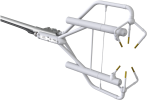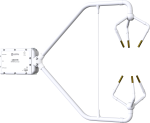
Gas analyzer and sonic anemometer in one sensor






Overview
Campbell Scientific’s IRGASON® fully integrates the open-path analyzer and sonic anemometer. Designed specifically for eddy-covariance carbon and water flux measurements, the patented design is easier to install and use than separate sensors and provides increased measurement accuracy. The IRGASON simultaneously measures absolute carbon dioxide and water vapor, air temperature, barometric pressure, three-dimensional wind speed, and sonic air temperature. U.S. patent D680455
For more information about the benefits of having a colocated measurement, refer to the poster "Improved eddy flux measurements by open-path gas analyzer and sonic anemometer co-location."
Read MoreBenefits and Features
- New conformal coating helps protect sonic transducers in corrosive environments
- Combined support structure causes less flow distortion than two separate sensors
- Truly colocated gas analyzer and sonic anemometer measurements avoid flux loss due to sensor separation
- Synchronized gas analyzer and sonic anemometer measurements avoid the need to correct for time lag
- Low power consumption; suitable for solar power applications
- Measurements are temperature compensated without active heat control
- Low noise
- Maximum output rate of 60 Hz with 20 Hz bandwidth
- Angled windows shed water and are tolerant to window contamination
- Field rugged
- Field serviceable
- Factory calibrated over wide range of CO2, H2O, pressure, and temperature in all combinations encountered in practice
- Extensive set of diagnostic parameters
- Fully compatible with Campbell Scientific dataloggers; field setup, configuration, and field zero and span can be accomplished directly from the datalogger
- Sonic temperature determined from three acoustic paths; corrected for crosswind effects
- Innovative signal processing and transducer wicks considerably improve performance of the anemometer during precipitation events
EasyFlux® DL is a free CRBasic program for Campbell open-path eddy-covariance systems that is available in the Downloads section. To learn more about EasyFlux® DL, visit the software product's web page.
Images





Detailed Description
The IRGASON has the following outputs:
- Ux (m/s)
- Uy (m/s)
- Uz (m/s)
- Sonic Temperature (°C)
- Sonic Diagnostic
- CO2 Density (mg/m3)
- H2O Density (g/m3)
- Gas Analyzer Diagnostic
- Ambient Temperature (°C)
- Atmospheric Pressure (kPa)
- CO2 Signal Strength
- H2O Signal Strength
- Source Temperature (°C)
Specifications
| Patent | U.S. Patent No. D680455 |
| Operating Temperature Range | -30° to +50°C |
| Calibrated Pressure Range | 70 to 106 kPa |
| Input Voltage Range | 10 to 16 Vdc |
| Power | 5 W (steady state and power up) at 25°C |
| Measurement Rate | 60 Hz |
| Output Bandwidth | 5, 10, 12.5, or 20 Hz (user-programmable) |
| Output Options | SDM, RS-485, USB, analog (CO2 and H2O only) |
| Auxiliary Inputs | Air temperature and pressure |
| Warranty | 3 years or 17,500 hours of operation (whichever comes first) |
| Cable Length | 3 m (10 ft) from IRGASON® to EC100 |
| Weight |
|
Gas Analyzer |
|
| Path Length |
15.37 cm (6.05 in.) A temperature of 20°C and pressure of 101.325 kPa was used to convert mass density to concentration. |
Gas Analyzer - CO2 Performance |
|
| -NOTE- | A temperature of 20°C and pressure of 101.325 kPa was used to convert mass density to concentration. |
| Accuracy |
|
| Precision RMS (maximum) |
0.2 mg/m3 (0.15 μmol/mol) Nominal conditions for precision verification test: 25°C, 86 kPa, 400 μmol/mol CO2, 12°C dewpoint, and 20 Hz bandwidth. |
| Calibrated Range | 0 to 1,000 μmol/mol (0 to 3,000 μmol/mol available upon request.) |
| Zero Drift with Temperature (maximum) | ±0.55 mg/m3/°C (±0.3 μmol/mol/°C) |
| Gain Drift with Temperature (maximum) | ±0.1% of reading/°C |
| Cross Sensitivity (maximum) | ±1.1 x 10-4 mol CO2/mol H2O |
Gas Analyzer - H2O Performance |
|
| -NOTE- | A temperature of 20°C and pressure of 101.325 kPa was used to convert mass density to concentration. |
| Accuracy |
|
| Precision RMS (maximum) |
0.004 g/m3 (0.006 mmol/mol) Nominal conditions for precision verification test: 25°C, 86 kPa, 400 μmol/mol CO2, 12°C dewpoint, and 20 Hz bandwidth. |
| Calibrated Range | 0 to 72 mmol/mol (38°C dewpoint) |
| Zero Drift with Temperature (maximum) | ±0.037 g/m3/°C (±0.05 mmol/mol/°C) |
| Gain Drift with Temperature (maximum) | ±0.3% of reading/°C |
| Cross Sensitivity (maximum) | ±0.1 mol H2O/mol CO2 |
Sonic Anemometer - Accuracy |
|
| -NOTE- | The accuracy specification for the sonic anemometer is for wind speeds < 30 m s-1 and wind angles between ±170°. |
| Offset Error |
|
| Gain Error |
|
| Measurement Precision RMS |
|
| Speed of Sound | Determined from 3 acoustic paths (corrected for crosswind effects) |
| Rain | Innovative signal processing and transducer wicks considerably improve performance of the anemometer during precipitation events. |
Basic Barometer (option -BB) |
|
| Total Accuracy |
|
| Measurement Rate | 10 Hz |
Enhanced Barometer (option -EB) |
|
| Manufacturer | Vaisala PTB110 |
| Total Accuracy | ±0.15 kPa (-30° to +50°C) |
| Measurement Rate | 1 Hz |
Ambient Temperature |
|
| Manufacturer | BetaTherm 100K6A1IA |
| Total Accuracy | ±0.15°C (-30° to +50°C) |
Related Documents
Manuals
Technical Papers
Miscellaneous
- Improved Flux Measurements from Campbell Scientific Open-Path Gas Analyzers: Utilizing Sonic Temperature to Account for Spectroscopic Effects on CO2 Density
- High-Frequency Air-Temperature Fluctuations for Spectroscopic Corrections
- Influence of Open-path Gas Analyzer Flow Distortion on Ultrasonic Wind Measurements
- Benefits of Having a Co-Located Measurement
- Using Molecular Sieve to Zero Infrared Gas Analyzers for Eddy Covariance or Atmospheric Profile Measurements
- Qingyuan Project Update
Videos & Tutorials
Downloads
EasyFlux DL for CR6OP v.2.01 (98.2 KB) 21-07-2022
CR6 datalogger program for Campbell open-path eddy-covariance systems.
EC100 OS v.8.02 (560 KB) 14-10-2019
EC100 Operating System.
Watch the Video Tutorial: Updating the EC100 Operating System.
ECMon v.1.6 (10.7 MB) 29-03-2016
EC100-Series Support Software.
Device Configuration Utility v.2.29 (54 MB) 15-11-2023
A software utility used to download operating systems and set up Campbell Scientific hardware. Also will update PakBus Graph and the Network Planner if they have been installed previously by another Campbell Scientific software package.
Supported Operating Systems:
Windows 11 or 10 (Both 32 and 64 bit)
EasyFlux DL for CR1000XOP v.2.01 (98.2 KB) 21-07-2022
CR1000X datalogger program for Campbell open-path eddy-covariance systems.
Articles and Press Releases
Newsletter Articles
FAQs for
Number of FAQs related to IRGASON: 22
Expand AllCollapse All
-
The molecular sieve is a non-hazardous material that can be shipped to any country.
-
The molecular sieve is a direct replacement for the old magnesium perchlorate bottles. The molecular sieve may be used for any Campbell Scientific analyzer that used the old bottles.
-
The bottles of sieve for drop-in replacement contain the pellets and a membrane on top. The membrane is necessary to keep the pellets contained while allowing gas to pass over the zeolite. The bottle has the same footprint as the old magnesium perchlorate bottles. The amount in each bottle is listed on the bottle. The amount of sieve needed for each analyzer is the following:
- The EC150 needs 22 g (drop-in bottle).
- The IRGASON® needs 22 g (drop-in bottle).
- The EC155 needs 22 g (drop-in bottle).
- The AP200 needs 500 g (refill).
- The 27423 needs 1000 g (refill).
- The 31022 needs 500 g (refill).
-
The molecular sieve has been demonstrated here by our engineering department to be effective at removing CO2 and H2O from the air sample. The change was made for two reasons:
- It was a safer alternative than using the previous chemicals.
- Increased shipping regulations for the chemicals limited the number of suppliers.
-
The IRGASON® has been optimized for most terrestrial applications. If the IRGASON® is to be used in a marine environment or in an environment where it is exposed to corrosive chemicals (for example, sulfur-containing compounds in viticulture), expect the sonic transducers to age more quickly and require replacement sooner than a unit deployed in an inland, chemical-free environment. If possible, mount the IRGASON® in a way that reduces exposure to saltwater spray/splash and/or corrosive chemicals.
-
The EC150 and IRGASON® gas analyzer windows are polished, slanted at an angle, and coated with a hydrophobic material to prevent water from collecting on their surfaces. Wicks may also be used on the windows to promote capillary action and move water away from the window edges. Also, heaters in the snouts may be turned on to help minimize data loss because of precipitation and condensation events.
-
The factory calibration accounts for CO2 and H2O signal strengths down to 0.7. Therefore, to ensure quality data, windows should be cleaned before signal strengths drop below 0.7.
-
Yes. A fine-wire thermocouple, such as a FW05, can be used.
-
The EC150 and IRGASON® can report a negative water concentration if enough liquid water accumulates on the optical windows. This is because the absorption spectrum of liquid water differs from that of water vapor. Typically, large rain droplets do not cause this phenomenon. Rather, misty or condensing conditions, which create a water film across the entire optical window, can cause this phenomenon. After the water film evaporates, the former measurement accuracy will be restored.
The IRGASON® and EC150 may also experience some amount of drift over time. If conditions are relatively dry and it has been a long time since a zero and span has been performed on the analyzer, it is possible to report a negative water vapor concentration. In this situation, perform a zero and span of the analyzer.
-
The IRGASON® is an integrated open-path gas analyzer and sonic anemometer, whereas the EC150 is a separate open-path gas analyzer that may be paired with a CSAT3A sonic anemometer. Both instruments provide measurements that are synchronous or simultaneous, made possible by having one set of electronics, the EC100, controlling the execution of both gas and wind measurements. With its integrated design, the IRGASON® is able to make measurements exactly colocated, which means that a spatial correction does not need to be applied to fluxes. Unlike the IRGASON®, the EC150 has measurement volumes that have a small separation, which means a spatial correction must be applied.
For more detailed information, see the white paper “EC150, IRGASON, or EC155: Which CO2 and H2O Eddy-Covariance System Is Best for My Application?”





